Importance of Strategic Management in Expanding Market: A Case Study of Lidl in Thailand
VerifiedAdded on 2023/01/19
|16
|4579
|52
AI Summary
This report discusses the importance of strategic management in expanding markets, using the case study of Lidl's expansion in Thailand. It covers topics such as PESTLE analysis, Porter's five forces, Bowman's clock strategies, and VRIO model.
Contribute Materials
Your contribution can guide someone’s learning journey. Share your
documents today.
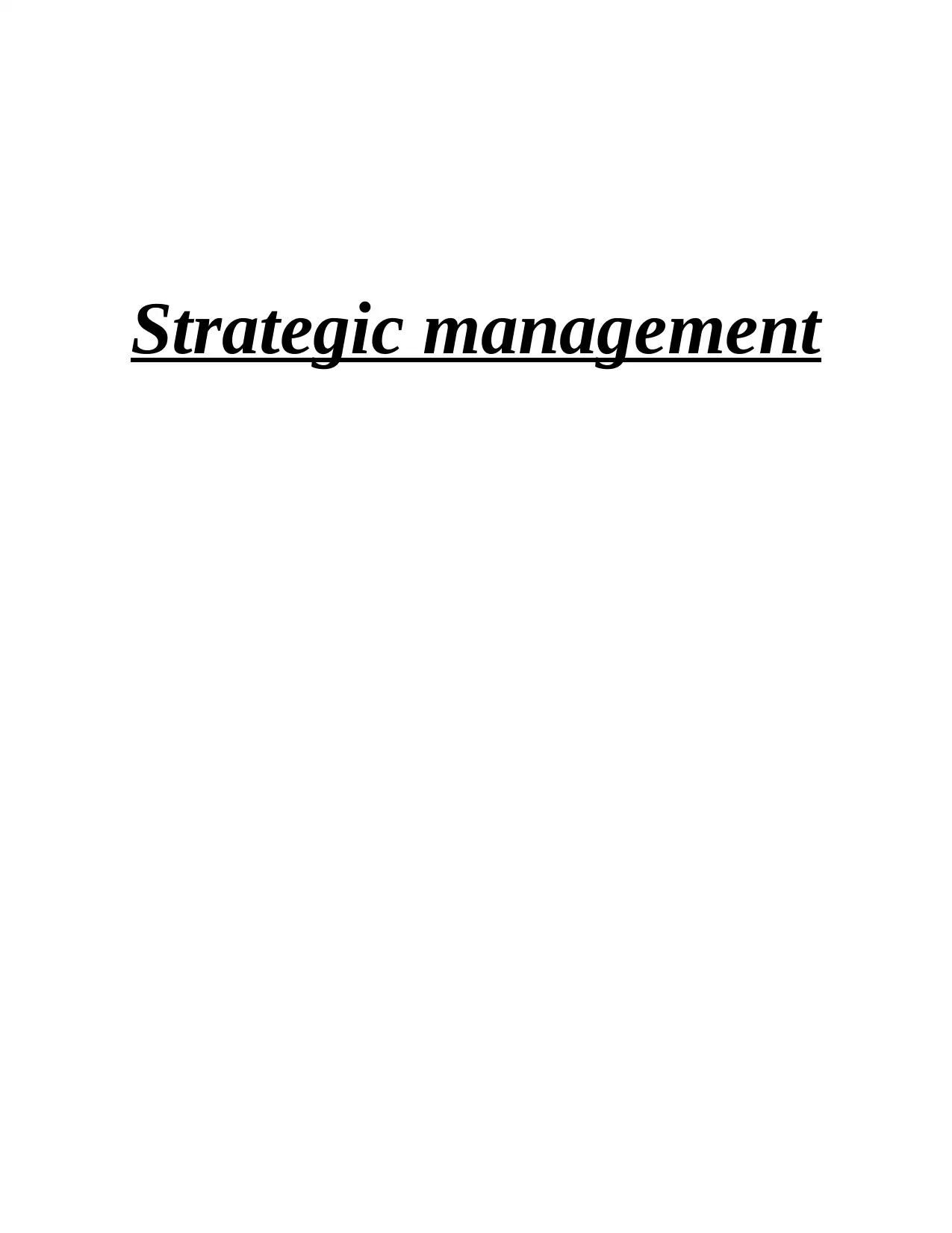
Strategic management
Secure Best Marks with AI Grader
Need help grading? Try our AI Grader for instant feedback on your assignments.
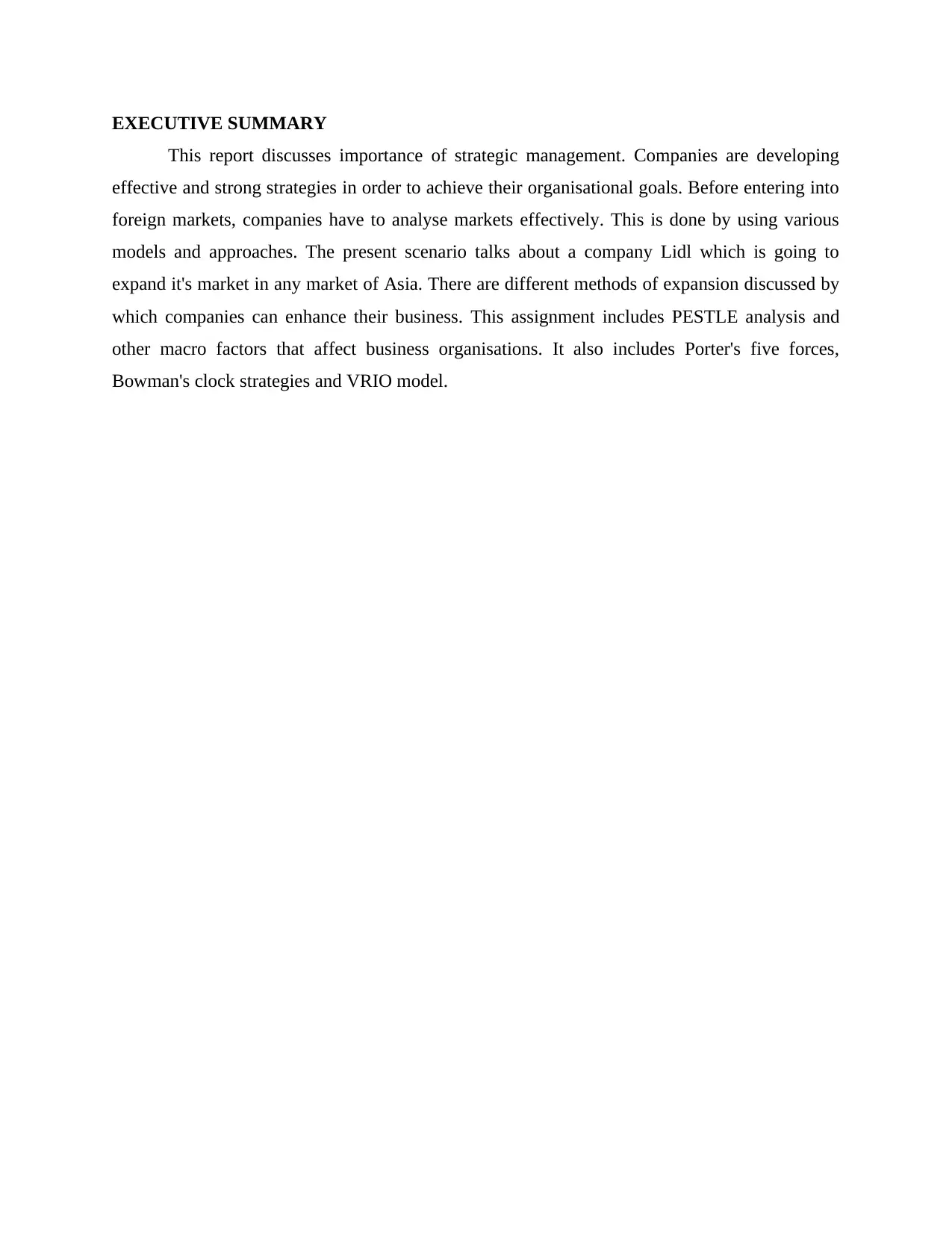
EXECUTIVE SUMMARY
This report discusses importance of strategic management. Companies are developing
effective and strong strategies in order to achieve their organisational goals. Before entering into
foreign markets, companies have to analyse markets effectively. This is done by using various
models and approaches. The present scenario talks about a company Lidl which is going to
expand it's market in any market of Asia. There are different methods of expansion discussed by
which companies can enhance their business. This assignment includes PESTLE analysis and
other macro factors that affect business organisations. It also includes Porter's five forces,
Bowman's clock strategies and VRIO model.
This report discusses importance of strategic management. Companies are developing
effective and strong strategies in order to achieve their organisational goals. Before entering into
foreign markets, companies have to analyse markets effectively. This is done by using various
models and approaches. The present scenario talks about a company Lidl which is going to
expand it's market in any market of Asia. There are different methods of expansion discussed by
which companies can enhance their business. This assignment includes PESTLE analysis and
other macro factors that affect business organisations. It also includes Porter's five forces,
Bowman's clock strategies and VRIO model.
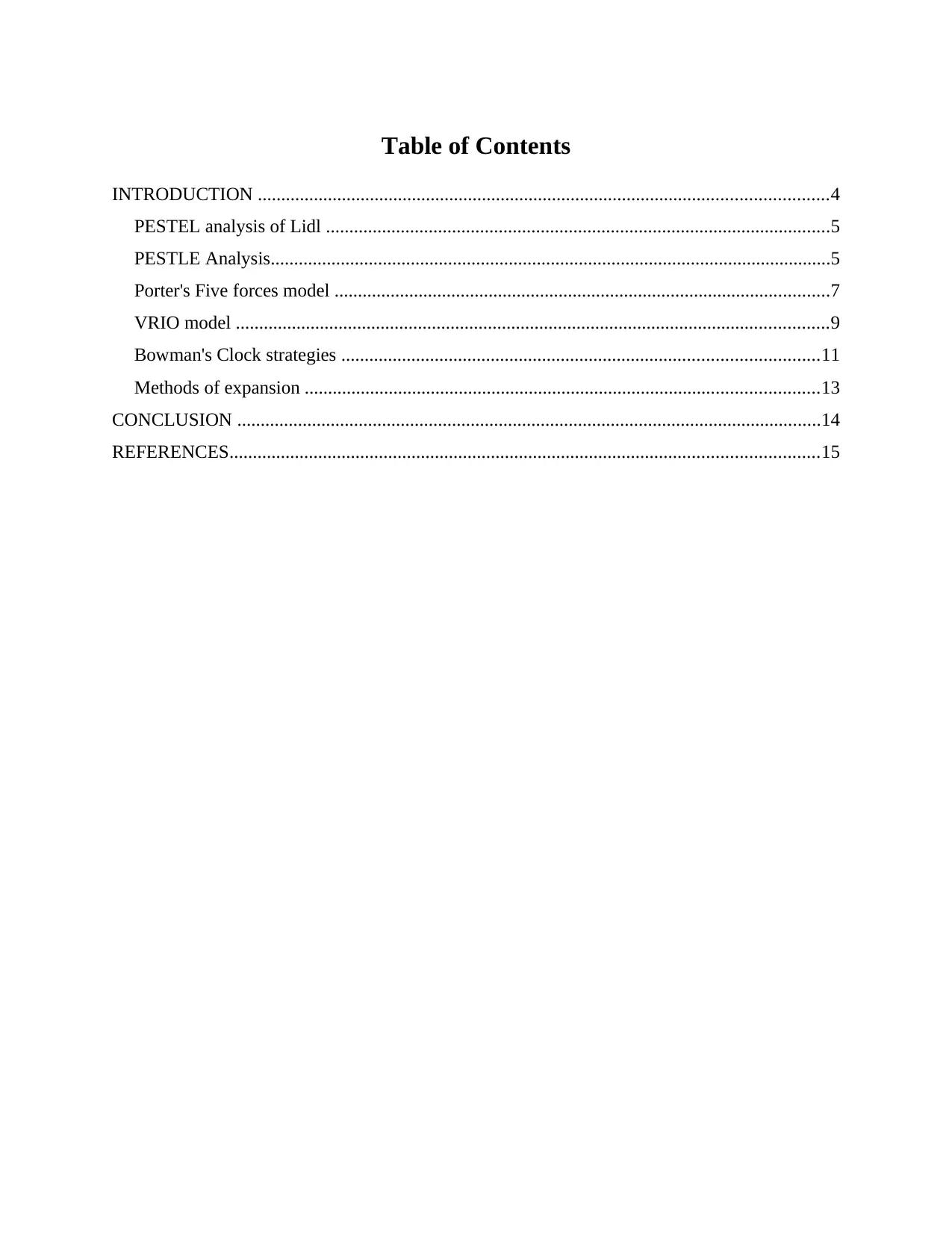
Table of Contents
INTRODUCTION ..........................................................................................................................4
PESTEL analysis of Lidl ............................................................................................................5
PESTLE Analysis........................................................................................................................5
Porter's Five forces model ..........................................................................................................7
VRIO model ...............................................................................................................................9
Bowman's Clock strategies ......................................................................................................11
Methods of expansion ..............................................................................................................13
CONCLUSION .............................................................................................................................14
REFERENCES..............................................................................................................................15
INTRODUCTION ..........................................................................................................................4
PESTEL analysis of Lidl ............................................................................................................5
PESTLE Analysis........................................................................................................................5
Porter's Five forces model ..........................................................................................................7
VRIO model ...............................................................................................................................9
Bowman's Clock strategies ......................................................................................................11
Methods of expansion ..............................................................................................................13
CONCLUSION .............................................................................................................................14
REFERENCES..............................................................................................................................15
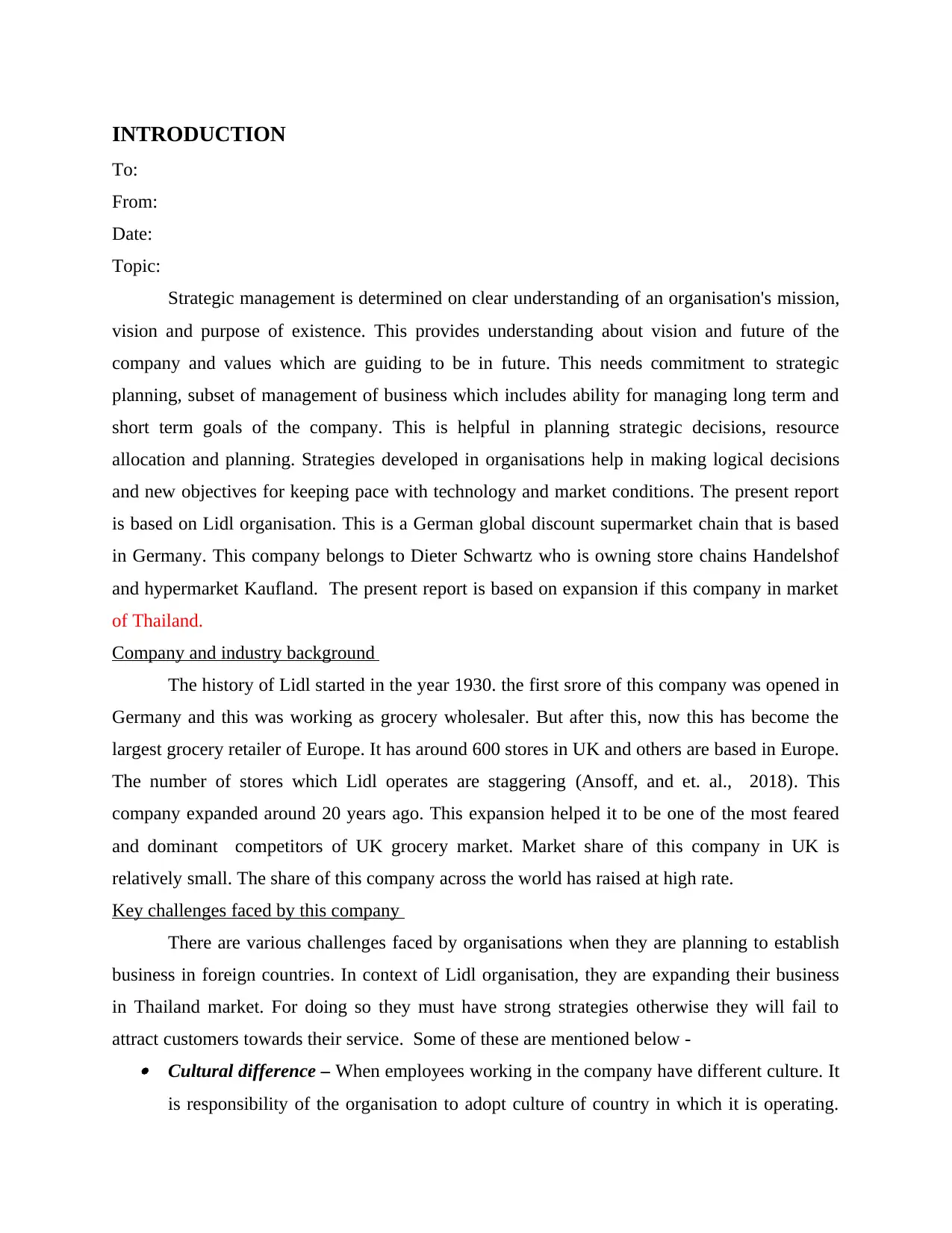
INTRODUCTION
To:
From:
Date:
Topic:
Strategic management is determined on clear understanding of an organisation's mission,
vision and purpose of existence. This provides understanding about vision and future of the
company and values which are guiding to be in future. This needs commitment to strategic
planning, subset of management of business which includes ability for managing long term and
short term goals of the company. This is helpful in planning strategic decisions, resource
allocation and planning. Strategies developed in organisations help in making logical decisions
and new objectives for keeping pace with technology and market conditions. The present report
is based on Lidl organisation. This is a German global discount supermarket chain that is based
in Germany. This company belongs to Dieter Schwartz who is owning store chains Handelshof
and hypermarket Kaufland. The present report is based on expansion if this company in market
of Thailand.
Company and industry background
The history of Lidl started in the year 1930. the first srore of this company was opened in
Germany and this was working as grocery wholesaler. But after this, now this has become the
largest grocery retailer of Europe. It has around 600 stores in UK and others are based in Europe.
The number of stores which Lidl operates are staggering (Ansoff, and et. al., 2018). This
company expanded around 20 years ago. This expansion helped it to be one of the most feared
and dominant competitors of UK grocery market. Market share of this company in UK is
relatively small. The share of this company across the world has raised at high rate.
Key challenges faced by this company
There are various challenges faced by organisations when they are planning to establish
business in foreign countries. In context of Lidl organisation, they are expanding their business
in Thailand market. For doing so they must have strong strategies otherwise they will fail to
attract customers towards their service. Some of these are mentioned below - Cultural difference – When employees working in the company have different culture. It
is responsibility of the organisation to adopt culture of country in which it is operating.
To:
From:
Date:
Topic:
Strategic management is determined on clear understanding of an organisation's mission,
vision and purpose of existence. This provides understanding about vision and future of the
company and values which are guiding to be in future. This needs commitment to strategic
planning, subset of management of business which includes ability for managing long term and
short term goals of the company. This is helpful in planning strategic decisions, resource
allocation and planning. Strategies developed in organisations help in making logical decisions
and new objectives for keeping pace with technology and market conditions. The present report
is based on Lidl organisation. This is a German global discount supermarket chain that is based
in Germany. This company belongs to Dieter Schwartz who is owning store chains Handelshof
and hypermarket Kaufland. The present report is based on expansion if this company in market
of Thailand.
Company and industry background
The history of Lidl started in the year 1930. the first srore of this company was opened in
Germany and this was working as grocery wholesaler. But after this, now this has become the
largest grocery retailer of Europe. It has around 600 stores in UK and others are based in Europe.
The number of stores which Lidl operates are staggering (Ansoff, and et. al., 2018). This
company expanded around 20 years ago. This expansion helped it to be one of the most feared
and dominant competitors of UK grocery market. Market share of this company in UK is
relatively small. The share of this company across the world has raised at high rate.
Key challenges faced by this company
There are various challenges faced by organisations when they are planning to establish
business in foreign countries. In context of Lidl organisation, they are expanding their business
in Thailand market. For doing so they must have strong strategies otherwise they will fail to
attract customers towards their service. Some of these are mentioned below - Cultural difference – When employees working in the company have different culture. It
is responsibility of the organisation to adopt culture of country in which it is operating.
Secure Best Marks with AI Grader
Need help grading? Try our AI Grader for instant feedback on your assignments.
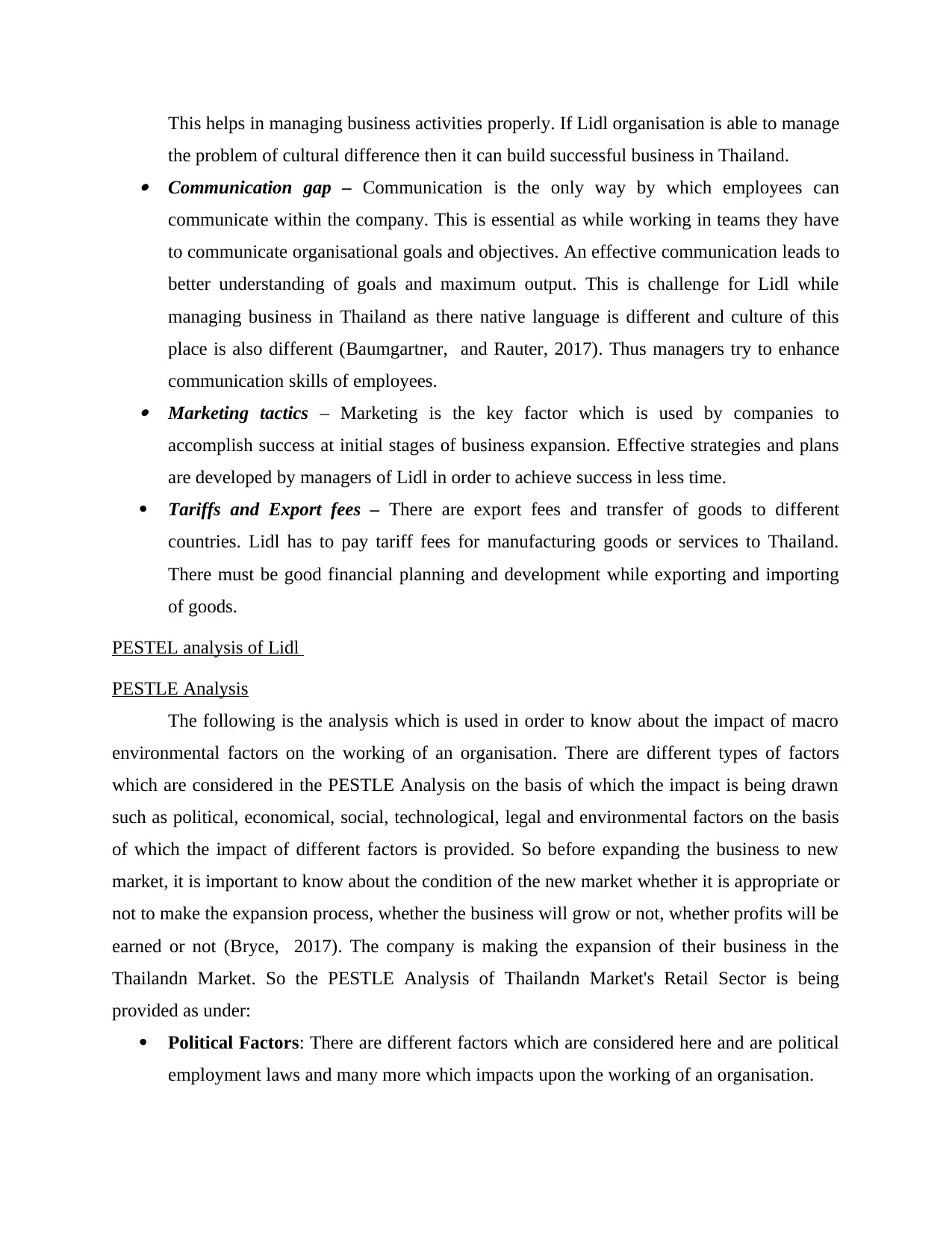
This helps in managing business activities properly. If Lidl organisation is able to manage
the problem of cultural difference then it can build successful business in Thailand. Communication gap – Communication is the only way by which employees can
communicate within the company. This is essential as while working in teams they have
to communicate organisational goals and objectives. An effective communication leads to
better understanding of goals and maximum output. This is challenge for Lidl while
managing business in Thailand as there native language is different and culture of this
place is also different (Baumgartner, and Rauter, 2017). Thus managers try to enhance
communication skills of employees. Marketing tactics – Marketing is the key factor which is used by companies to
accomplish success at initial stages of business expansion. Effective strategies and plans
are developed by managers of Lidl in order to achieve success in less time.
Tariffs and Export fees – There are export fees and transfer of goods to different
countries. Lidl has to pay tariff fees for manufacturing goods or services to Thailand.
There must be good financial planning and development while exporting and importing
of goods.
PESTEL analysis of Lidl
PESTLE Analysis
The following is the analysis which is used in order to know about the impact of macro
environmental factors on the working of an organisation. There are different types of factors
which are considered in the PESTLE Analysis on the basis of which the impact is being drawn
such as political, economical, social, technological, legal and environmental factors on the basis
of which the impact of different factors is provided. So before expanding the business to new
market, it is important to know about the condition of the new market whether it is appropriate or
not to make the expansion process, whether the business will grow or not, whether profits will be
earned or not (Bryce, 2017). The company is making the expansion of their business in the
Thailandn Market. So the PESTLE Analysis of Thailandn Market's Retail Sector is being
provided as under:
Political Factors: There are different factors which are considered here and are political
employment laws and many more which impacts upon the working of an organisation.
the problem of cultural difference then it can build successful business in Thailand. Communication gap – Communication is the only way by which employees can
communicate within the company. This is essential as while working in teams they have
to communicate organisational goals and objectives. An effective communication leads to
better understanding of goals and maximum output. This is challenge for Lidl while
managing business in Thailand as there native language is different and culture of this
place is also different (Baumgartner, and Rauter, 2017). Thus managers try to enhance
communication skills of employees. Marketing tactics – Marketing is the key factor which is used by companies to
accomplish success at initial stages of business expansion. Effective strategies and plans
are developed by managers of Lidl in order to achieve success in less time.
Tariffs and Export fees – There are export fees and transfer of goods to different
countries. Lidl has to pay tariff fees for manufacturing goods or services to Thailand.
There must be good financial planning and development while exporting and importing
of goods.
PESTEL analysis of Lidl
PESTLE Analysis
The following is the analysis which is used in order to know about the impact of macro
environmental factors on the working of an organisation. There are different types of factors
which are considered in the PESTLE Analysis on the basis of which the impact is being drawn
such as political, economical, social, technological, legal and environmental factors on the basis
of which the impact of different factors is provided. So before expanding the business to new
market, it is important to know about the condition of the new market whether it is appropriate or
not to make the expansion process, whether the business will grow or not, whether profits will be
earned or not (Bryce, 2017). The company is making the expansion of their business in the
Thailandn Market. So the PESTLE Analysis of Thailandn Market's Retail Sector is being
provided as under:
Political Factors: There are different factors which are considered here and are political
employment laws and many more which impacts upon the working of an organisation.
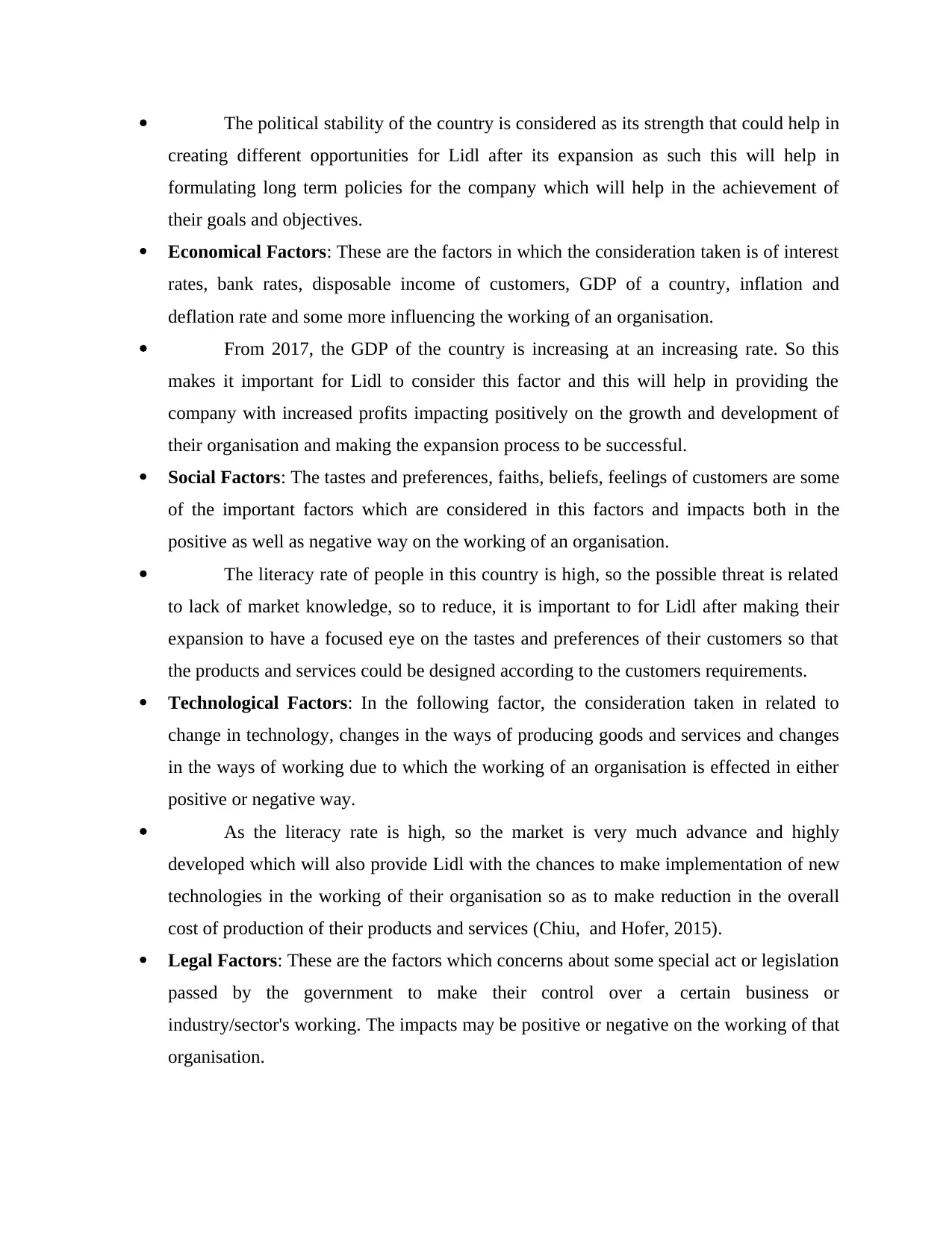
The political stability of the country is considered as its strength that could help in
creating different opportunities for Lidl after its expansion as such this will help in
formulating long term policies for the company which will help in the achievement of
their goals and objectives.
Economical Factors: These are the factors in which the consideration taken is of interest
rates, bank rates, disposable income of customers, GDP of a country, inflation and
deflation rate and some more influencing the working of an organisation.
From 2017, the GDP of the country is increasing at an increasing rate. So this
makes it important for Lidl to consider this factor and this will help in providing the
company with increased profits impacting positively on the growth and development of
their organisation and making the expansion process to be successful.
Social Factors: The tastes and preferences, faiths, beliefs, feelings of customers are some
of the important factors which are considered in this factors and impacts both in the
positive as well as negative way on the working of an organisation.
The literacy rate of people in this country is high, so the possible threat is related
to lack of market knowledge, so to reduce, it is important to for Lidl after making their
expansion to have a focused eye on the tastes and preferences of their customers so that
the products and services could be designed according to the customers requirements.
Technological Factors: In the following factor, the consideration taken in related to
change in technology, changes in the ways of producing goods and services and changes
in the ways of working due to which the working of an organisation is effected in either
positive or negative way.
As the literacy rate is high, so the market is very much advance and highly
developed which will also provide Lidl with the chances to make implementation of new
technologies in the working of their organisation so as to make reduction in the overall
cost of production of their products and services (Chiu, and Hofer, 2015).
Legal Factors: These are the factors which concerns about some special act or legislation
passed by the government to make their control over a certain business or
industry/sector's working. The impacts may be positive or negative on the working of that
organisation.
creating different opportunities for Lidl after its expansion as such this will help in
formulating long term policies for the company which will help in the achievement of
their goals and objectives.
Economical Factors: These are the factors in which the consideration taken is of interest
rates, bank rates, disposable income of customers, GDP of a country, inflation and
deflation rate and some more influencing the working of an organisation.
From 2017, the GDP of the country is increasing at an increasing rate. So this
makes it important for Lidl to consider this factor and this will help in providing the
company with increased profits impacting positively on the growth and development of
their organisation and making the expansion process to be successful.
Social Factors: The tastes and preferences, faiths, beliefs, feelings of customers are some
of the important factors which are considered in this factors and impacts both in the
positive as well as negative way on the working of an organisation.
The literacy rate of people in this country is high, so the possible threat is related
to lack of market knowledge, so to reduce, it is important to for Lidl after making their
expansion to have a focused eye on the tastes and preferences of their customers so that
the products and services could be designed according to the customers requirements.
Technological Factors: In the following factor, the consideration taken in related to
change in technology, changes in the ways of producing goods and services and changes
in the ways of working due to which the working of an organisation is effected in either
positive or negative way.
As the literacy rate is high, so the market is very much advance and highly
developed which will also provide Lidl with the chances to make implementation of new
technologies in the working of their organisation so as to make reduction in the overall
cost of production of their products and services (Chiu, and Hofer, 2015).
Legal Factors: These are the factors which concerns about some special act or legislation
passed by the government to make their control over a certain business or
industry/sector's working. The impacts may be positive or negative on the working of that
organisation.
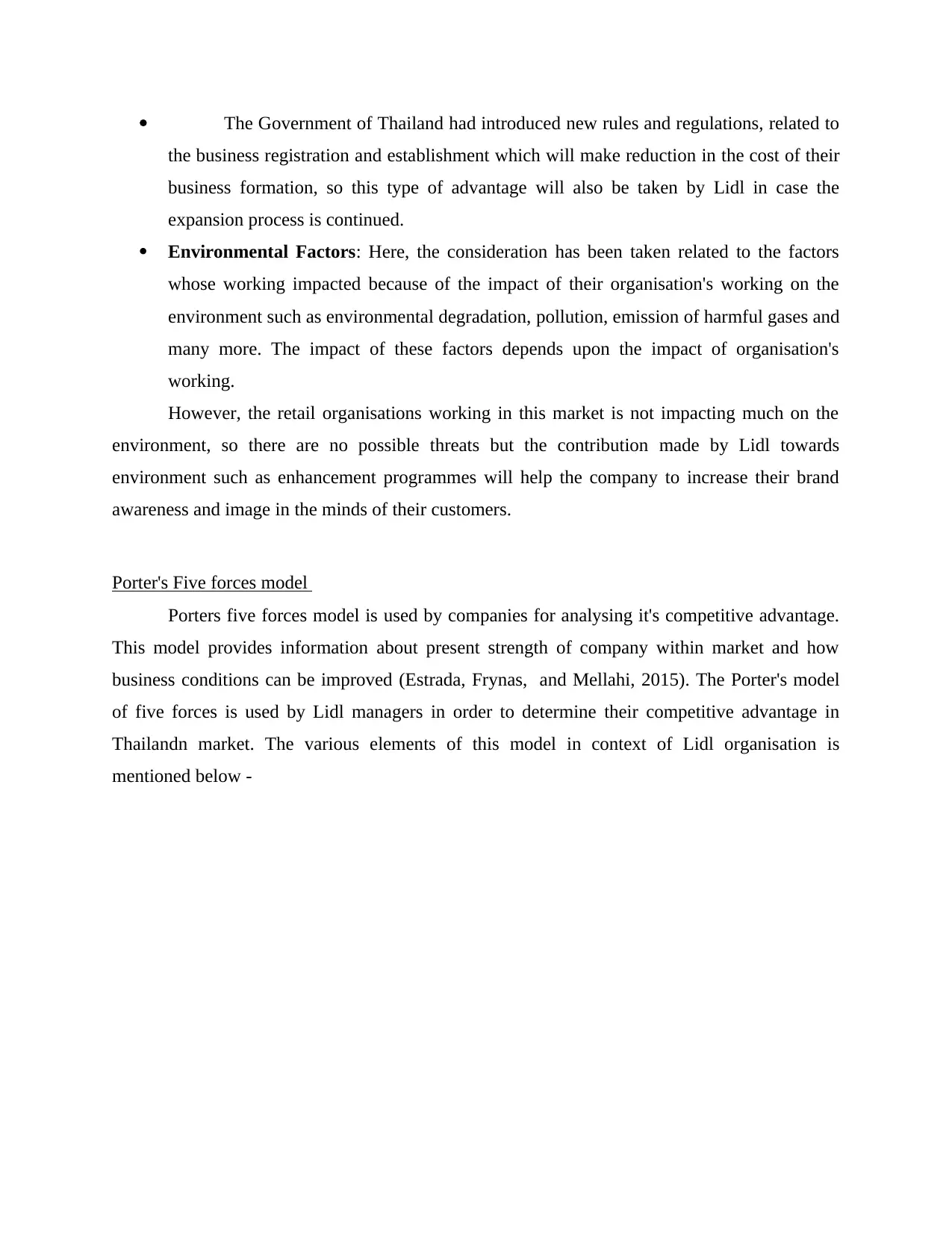
The Government of Thailand had introduced new rules and regulations, related to
the business registration and establishment which will make reduction in the cost of their
business formation, so this type of advantage will also be taken by Lidl in case the
expansion process is continued.
Environmental Factors: Here, the consideration has been taken related to the factors
whose working impacted because of the impact of their organisation's working on the
environment such as environmental degradation, pollution, emission of harmful gases and
many more. The impact of these factors depends upon the impact of organisation's
working.
However, the retail organisations working in this market is not impacting much on the
environment, so there are no possible threats but the contribution made by Lidl towards
environment such as enhancement programmes will help the company to increase their brand
awareness and image in the minds of their customers.
Porter's Five forces model
Porters five forces model is used by companies for analysing it's competitive advantage.
This model provides information about present strength of company within market and how
business conditions can be improved (Estrada, Frynas, and Mellahi, 2015). The Porter's model
of five forces is used by Lidl managers in order to determine their competitive advantage in
Thailandn market. The various elements of this model in context of Lidl organisation is
mentioned below -
the business registration and establishment which will make reduction in the cost of their
business formation, so this type of advantage will also be taken by Lidl in case the
expansion process is continued.
Environmental Factors: Here, the consideration has been taken related to the factors
whose working impacted because of the impact of their organisation's working on the
environment such as environmental degradation, pollution, emission of harmful gases and
many more. The impact of these factors depends upon the impact of organisation's
working.
However, the retail organisations working in this market is not impacting much on the
environment, so there are no possible threats but the contribution made by Lidl towards
environment such as enhancement programmes will help the company to increase their brand
awareness and image in the minds of their customers.
Porter's Five forces model
Porters five forces model is used by companies for analysing it's competitive advantage.
This model provides information about present strength of company within market and how
business conditions can be improved (Estrada, Frynas, and Mellahi, 2015). The Porter's model
of five forces is used by Lidl managers in order to determine their competitive advantage in
Thailandn market. The various elements of this model in context of Lidl organisation is
mentioned below -
Paraphrase This Document
Need a fresh take? Get an instant paraphrase of this document with our AI Paraphraser
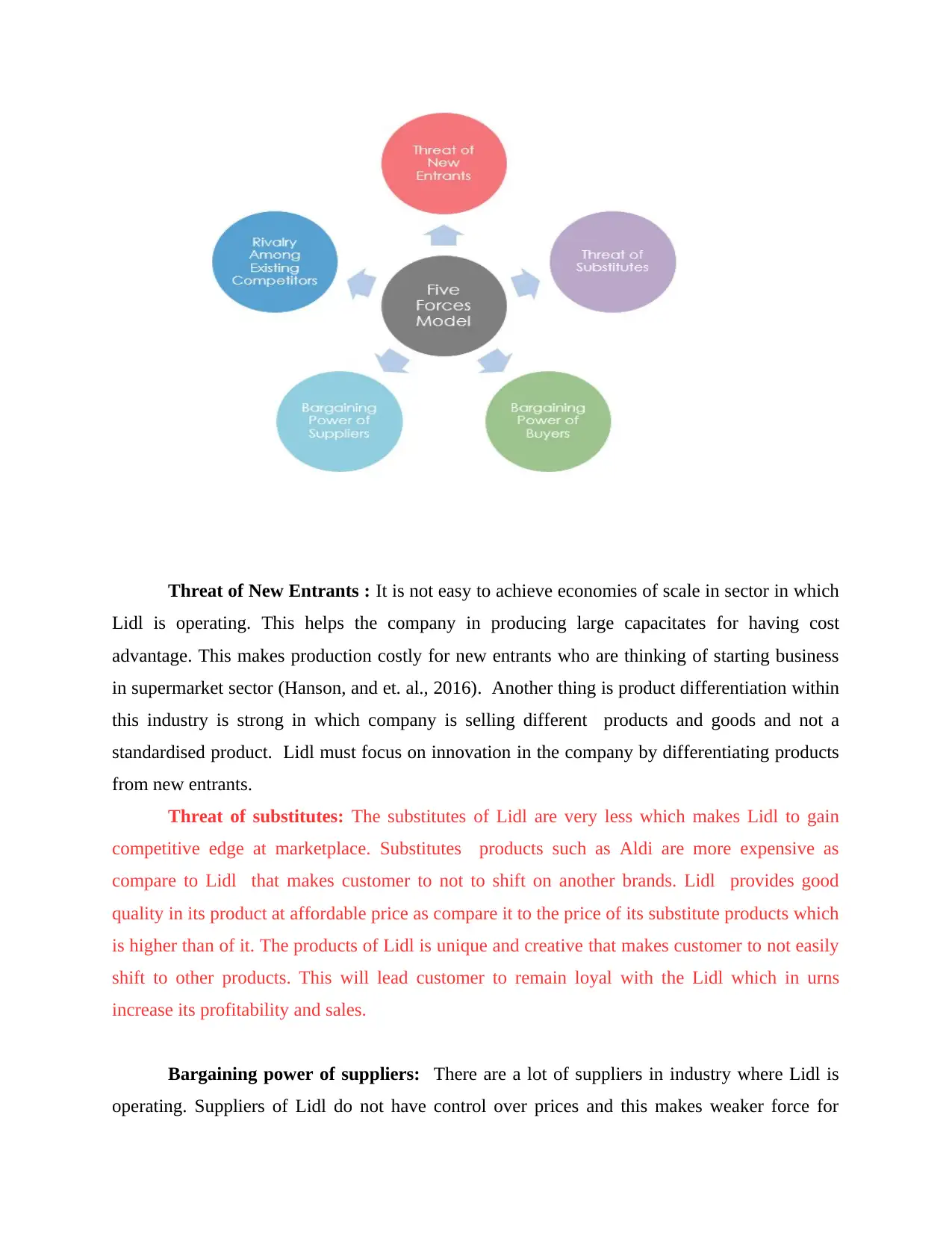
Threat of New Entrants : It is not easy to achieve economies of scale in sector in which
Lidl is operating. This helps the company in producing large capacitates for having cost
advantage. This makes production costly for new entrants who are thinking of starting business
in supermarket sector (Hanson, and et. al., 2016). Another thing is product differentiation within
this industry is strong in which company is selling different products and goods and not a
standardised product. Lidl must focus on innovation in the company by differentiating products
from new entrants.
Threat of substitutes: The substitutes of Lidl are very less which makes Lidl to gain
competitive edge at marketplace. Substitutes products such as Aldi are more expensive as
compare to Lidl that makes customer to not to shift on another brands. Lidl provides good
quality in its product at affordable price as compare it to the price of its substitute products which
is higher than of it. The products of Lidl is unique and creative that makes customer to not easily
shift to other products. This will lead customer to remain loyal with the Lidl which in urns
increase its profitability and sales.
Bargaining power of suppliers: There are a lot of suppliers in industry where Lidl is
operating. Suppliers of Lidl do not have control over prices and this makes weaker force for
Lidl is operating. This helps the company in producing large capacitates for having cost
advantage. This makes production costly for new entrants who are thinking of starting business
in supermarket sector (Hanson, and et. al., 2016). Another thing is product differentiation within
this industry is strong in which company is selling different products and goods and not a
standardised product. Lidl must focus on innovation in the company by differentiating products
from new entrants.
Threat of substitutes: The substitutes of Lidl are very less which makes Lidl to gain
competitive edge at marketplace. Substitutes products such as Aldi are more expensive as
compare to Lidl that makes customer to not to shift on another brands. Lidl provides good
quality in its product at affordable price as compare it to the price of its substitute products which
is higher than of it. The products of Lidl is unique and creative that makes customer to not easily
shift to other products. This will lead customer to remain loyal with the Lidl which in urns
increase its profitability and sales.
Bargaining power of suppliers: There are a lot of suppliers in industry where Lidl is
operating. Suppliers of Lidl do not have control over prices and this makes weaker force for
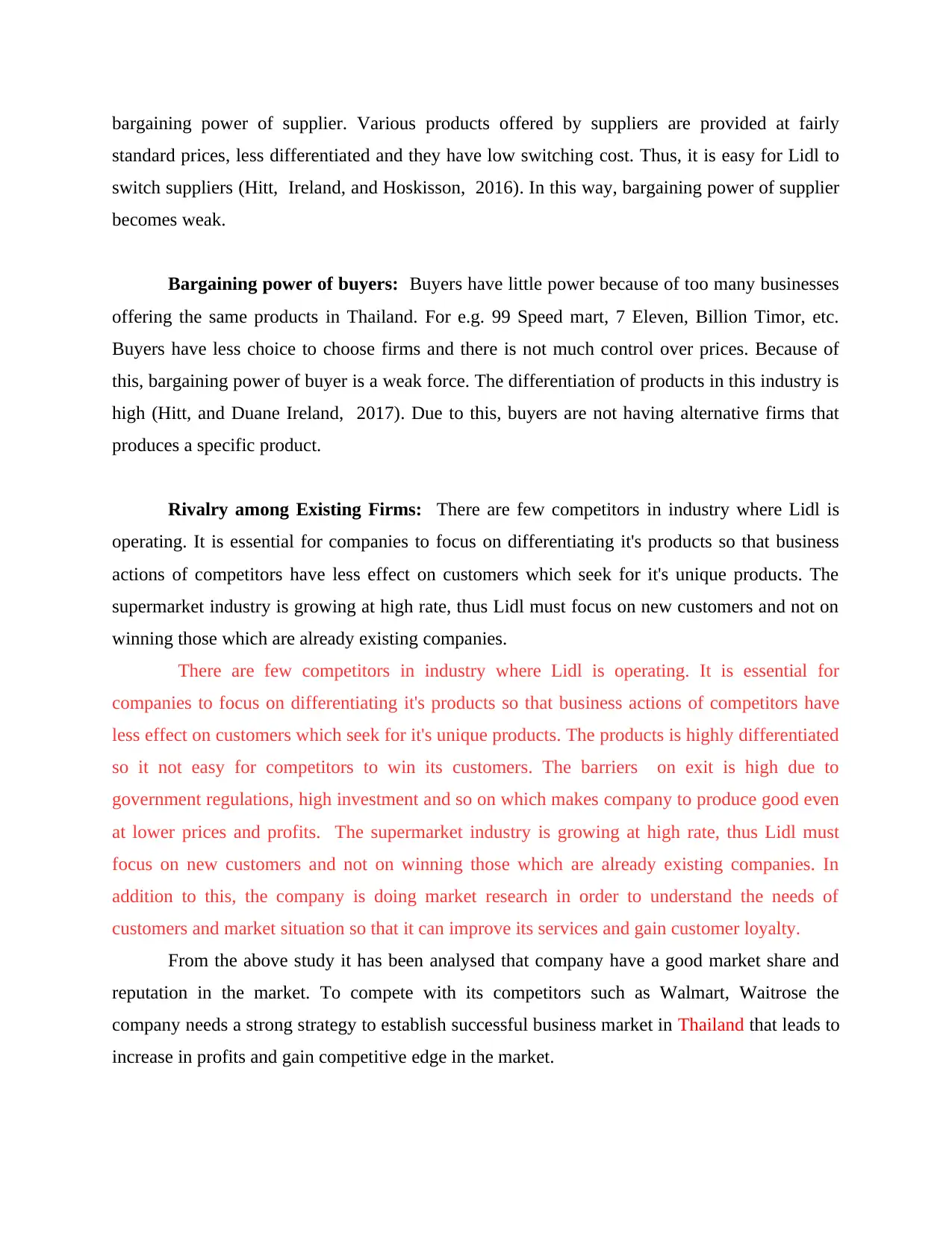
bargaining power of supplier. Various products offered by suppliers are provided at fairly
standard prices, less differentiated and they have low switching cost. Thus, it is easy for Lidl to
switch suppliers (Hitt, Ireland, and Hoskisson, 2016). In this way, bargaining power of supplier
becomes weak.
Bargaining power of buyers: Buyers have little power because of too many businesses
offering the same products in Thailand. For e.g. 99 Speed mart, 7 Eleven, Billion Timor, etc.
Buyers have less choice to choose firms and there is not much control over prices. Because of
this, bargaining power of buyer is a weak force. The differentiation of products in this industry is
high (Hitt, and Duane Ireland, 2017). Due to this, buyers are not having alternative firms that
produces a specific product.
Rivalry among Existing Firms: There are few competitors in industry where Lidl is
operating. It is essential for companies to focus on differentiating it's products so that business
actions of competitors have less effect on customers which seek for it's unique products. The
supermarket industry is growing at high rate, thus Lidl must focus on new customers and not on
winning those which are already existing companies.
There are few competitors in industry where Lidl is operating. It is essential for
companies to focus on differentiating it's products so that business actions of competitors have
less effect on customers which seek for it's unique products. The products is highly differentiated
so it not easy for competitors to win its customers. The barriers on exit is high due to
government regulations, high investment and so on which makes company to produce good even
at lower prices and profits. The supermarket industry is growing at high rate, thus Lidl must
focus on new customers and not on winning those which are already existing companies. In
addition to this, the company is doing market research in order to understand the needs of
customers and market situation so that it can improve its services and gain customer loyalty.
From the above study it has been analysed that company have a good market share and
reputation in the market. To compete with its competitors such as Walmart, Waitrose the
company needs a strong strategy to establish successful business market in Thailand that leads to
increase in profits and gain competitive edge in the market.
standard prices, less differentiated and they have low switching cost. Thus, it is easy for Lidl to
switch suppliers (Hitt, Ireland, and Hoskisson, 2016). In this way, bargaining power of supplier
becomes weak.
Bargaining power of buyers: Buyers have little power because of too many businesses
offering the same products in Thailand. For e.g. 99 Speed mart, 7 Eleven, Billion Timor, etc.
Buyers have less choice to choose firms and there is not much control over prices. Because of
this, bargaining power of buyer is a weak force. The differentiation of products in this industry is
high (Hitt, and Duane Ireland, 2017). Due to this, buyers are not having alternative firms that
produces a specific product.
Rivalry among Existing Firms: There are few competitors in industry where Lidl is
operating. It is essential for companies to focus on differentiating it's products so that business
actions of competitors have less effect on customers which seek for it's unique products. The
supermarket industry is growing at high rate, thus Lidl must focus on new customers and not on
winning those which are already existing companies.
There are few competitors in industry where Lidl is operating. It is essential for
companies to focus on differentiating it's products so that business actions of competitors have
less effect on customers which seek for it's unique products. The products is highly differentiated
so it not easy for competitors to win its customers. The barriers on exit is high due to
government regulations, high investment and so on which makes company to produce good even
at lower prices and profits. The supermarket industry is growing at high rate, thus Lidl must
focus on new customers and not on winning those which are already existing companies. In
addition to this, the company is doing market research in order to understand the needs of
customers and market situation so that it can improve its services and gain customer loyalty.
From the above study it has been analysed that company have a good market share and
reputation in the market. To compete with its competitors such as Walmart, Waitrose the
company needs a strong strategy to establish successful business market in Thailand that leads to
increase in profits and gain competitive edge in the market.
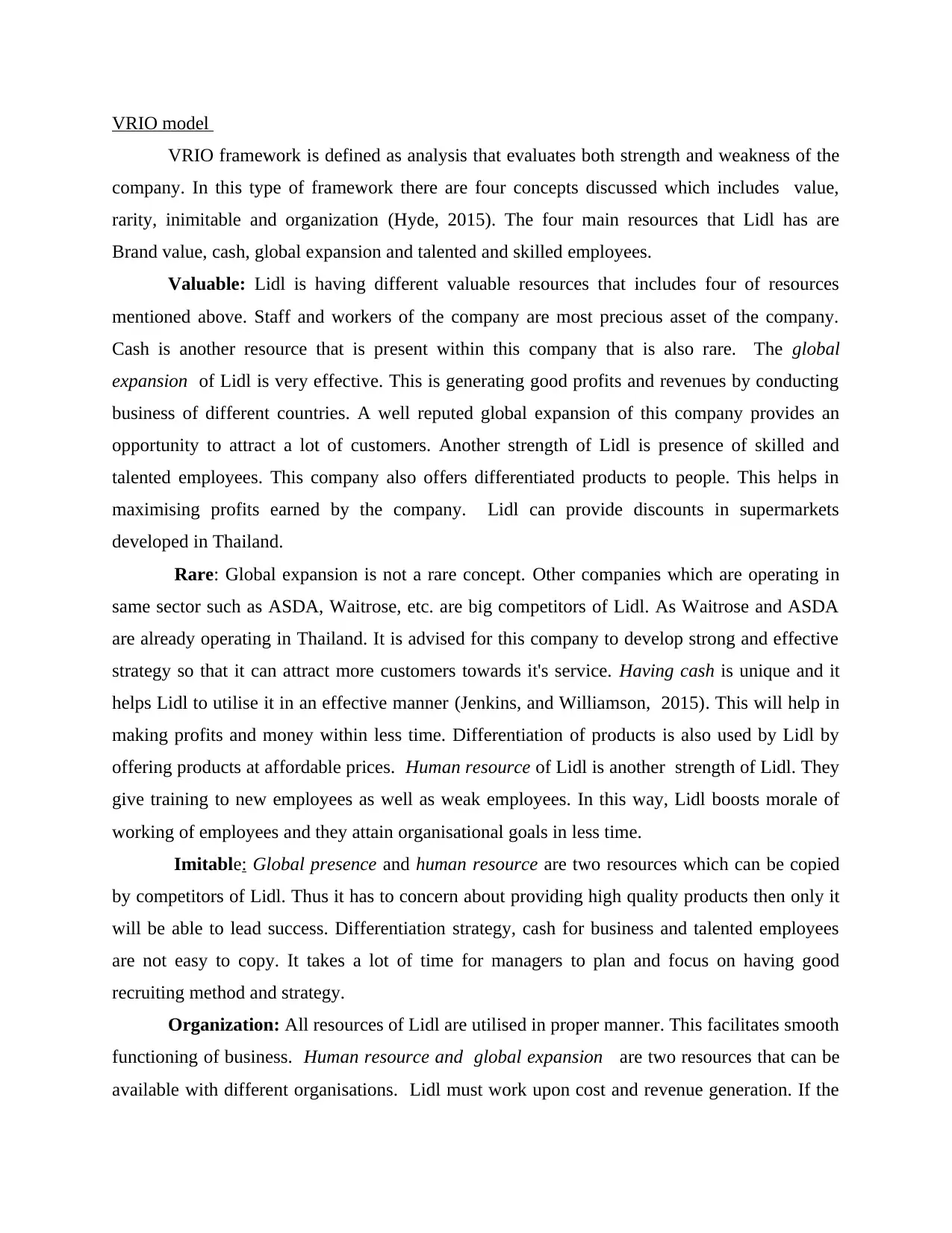
VRIO model
VRIO framework is defined as analysis that evaluates both strength and weakness of the
company. In this type of framework there are four concepts discussed which includes value,
rarity, inimitable and organization (Hyde, 2015). The four main resources that Lidl has are
Brand value, cash, global expansion and talented and skilled employees.
Valuable: Lidl is having different valuable resources that includes four of resources
mentioned above. Staff and workers of the company are most precious asset of the company.
Cash is another resource that is present within this company that is also rare. The global
expansion of Lidl is very effective. This is generating good profits and revenues by conducting
business of different countries. A well reputed global expansion of this company provides an
opportunity to attract a lot of customers. Another strength of Lidl is presence of skilled and
talented employees. This company also offers differentiated products to people. This helps in
maximising profits earned by the company. Lidl can provide discounts in supermarkets
developed in Thailand.
Rare: Global expansion is not a rare concept. Other companies which are operating in
same sector such as ASDA, Waitrose, etc. are big competitors of Lidl. As Waitrose and ASDA
are already operating in Thailand. It is advised for this company to develop strong and effective
strategy so that it can attract more customers towards it's service. Having cash is unique and it
helps Lidl to utilise it in an effective manner (Jenkins, and Williamson, 2015). This will help in
making profits and money within less time. Differentiation of products is also used by Lidl by
offering products at affordable prices. Human resource of Lidl is another strength of Lidl. They
give training to new employees as well as weak employees. In this way, Lidl boosts morale of
working of employees and they attain organisational goals in less time.
Imitable: Global presence and human resource are two resources which can be copied
by competitors of Lidl. Thus it has to concern about providing high quality products then only it
will be able to lead success. Differentiation strategy, cash for business and talented employees
are not easy to copy. It takes a lot of time for managers to plan and focus on having good
recruiting method and strategy.
Organization: All resources of Lidl are utilised in proper manner. This facilitates smooth
functioning of business. Human resource and global expansion are two resources that can be
available with different organisations. Lidl must work upon cost and revenue generation. If the
VRIO framework is defined as analysis that evaluates both strength and weakness of the
company. In this type of framework there are four concepts discussed which includes value,
rarity, inimitable and organization (Hyde, 2015). The four main resources that Lidl has are
Brand value, cash, global expansion and talented and skilled employees.
Valuable: Lidl is having different valuable resources that includes four of resources
mentioned above. Staff and workers of the company are most precious asset of the company.
Cash is another resource that is present within this company that is also rare. The global
expansion of Lidl is very effective. This is generating good profits and revenues by conducting
business of different countries. A well reputed global expansion of this company provides an
opportunity to attract a lot of customers. Another strength of Lidl is presence of skilled and
talented employees. This company also offers differentiated products to people. This helps in
maximising profits earned by the company. Lidl can provide discounts in supermarkets
developed in Thailand.
Rare: Global expansion is not a rare concept. Other companies which are operating in
same sector such as ASDA, Waitrose, etc. are big competitors of Lidl. As Waitrose and ASDA
are already operating in Thailand. It is advised for this company to develop strong and effective
strategy so that it can attract more customers towards it's service. Having cash is unique and it
helps Lidl to utilise it in an effective manner (Jenkins, and Williamson, 2015). This will help in
making profits and money within less time. Differentiation of products is also used by Lidl by
offering products at affordable prices. Human resource of Lidl is another strength of Lidl. They
give training to new employees as well as weak employees. In this way, Lidl boosts morale of
working of employees and they attain organisational goals in less time.
Imitable: Global presence and human resource are two resources which can be copied
by competitors of Lidl. Thus it has to concern about providing high quality products then only it
will be able to lead success. Differentiation strategy, cash for business and talented employees
are not easy to copy. It takes a lot of time for managers to plan and focus on having good
recruiting method and strategy.
Organization: All resources of Lidl are utilised in proper manner. This facilitates smooth
functioning of business. Human resource and global expansion are two resources that can be
available with different organisations. Lidl must work upon cost and revenue generation. If the
Secure Best Marks with AI Grader
Need help grading? Try our AI Grader for instant feedback on your assignments.
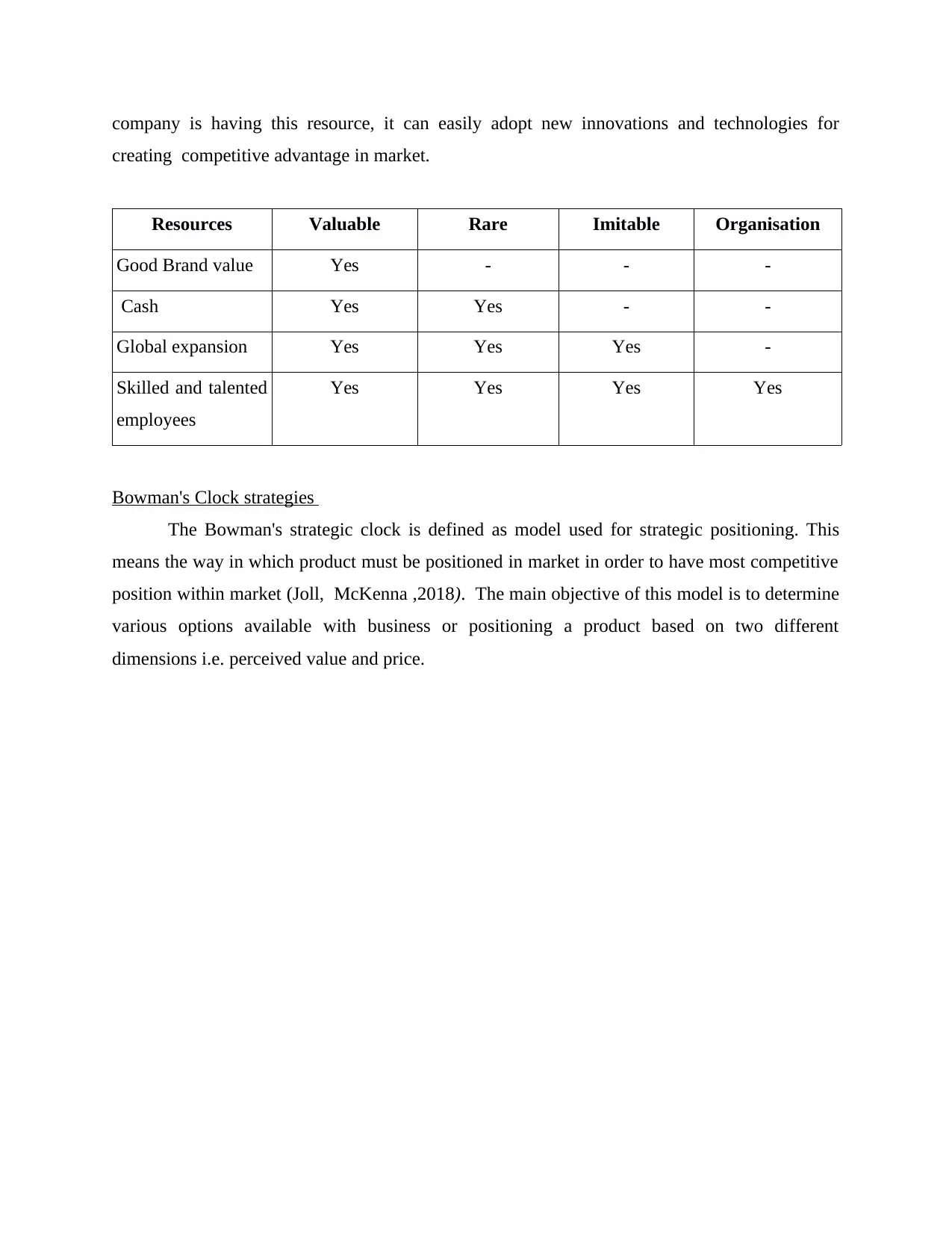
company is having this resource, it can easily adopt new innovations and technologies for
creating competitive advantage in market.
Resources Valuable Rare Imitable Organisation
Good Brand value Yes - - -
Cash Yes Yes - -
Global expansion Yes Yes Yes -
Skilled and talented
employees
Yes Yes Yes Yes
Bowman's Clock strategies
The Bowman's strategic clock is defined as model used for strategic positioning. This
means the way in which product must be positioned in market in order to have most competitive
position within market (Joll, McKenna ,2018). The main objective of this model is to determine
various options available with business or positioning a product based on two different
dimensions i.e. perceived value and price.
creating competitive advantage in market.
Resources Valuable Rare Imitable Organisation
Good Brand value Yes - - -
Cash Yes Yes - -
Global expansion Yes Yes Yes -
Skilled and talented
employees
Yes Yes Yes Yes
Bowman's Clock strategies
The Bowman's strategic clock is defined as model used for strategic positioning. This
means the way in which product must be positioned in market in order to have most competitive
position within market (Joll, McKenna ,2018). The main objective of this model is to determine
various options available with business or positioning a product based on two different
dimensions i.e. perceived value and price.
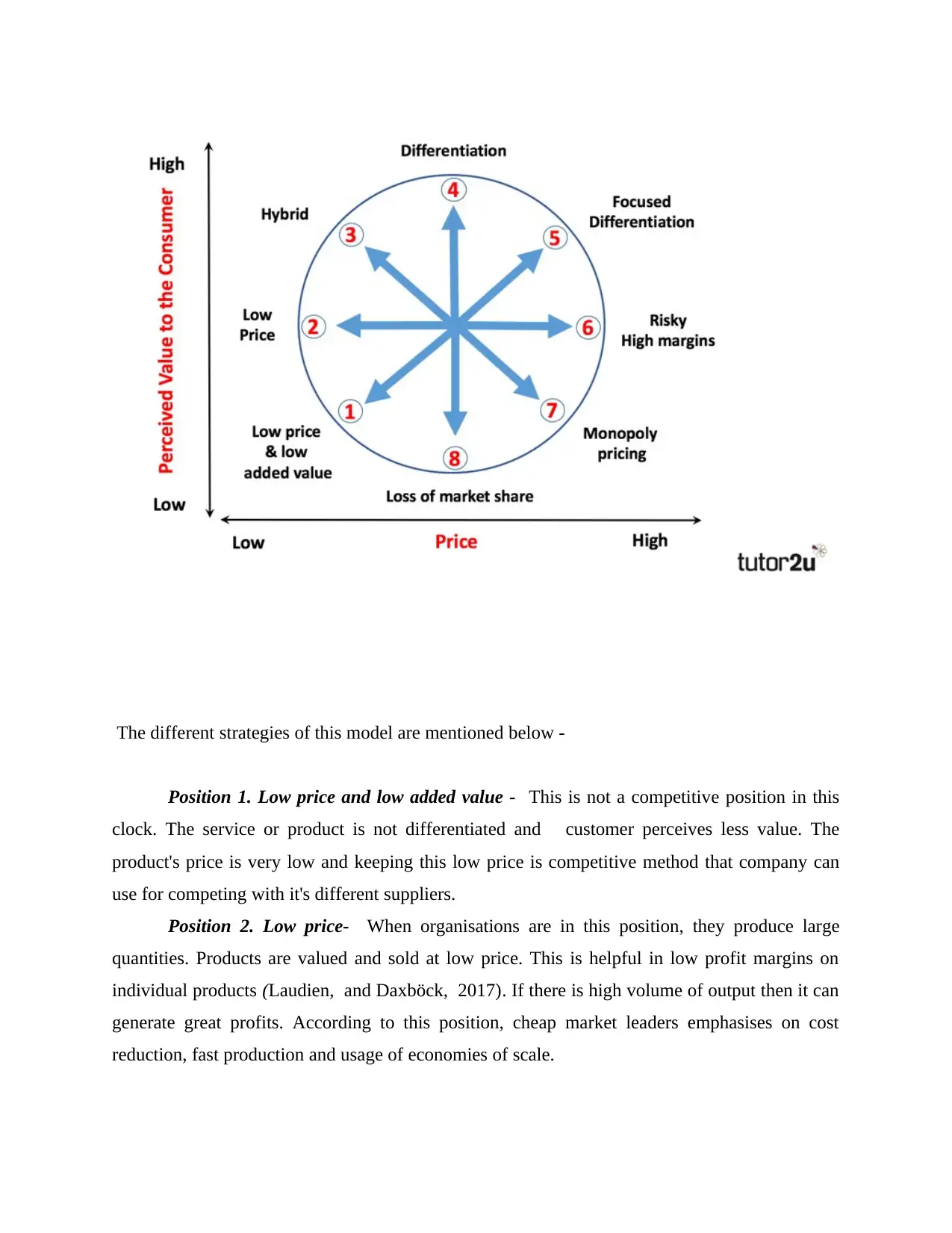
The different strategies of this model are mentioned below -
Position 1. Low price and low added value - This is not a competitive position in this
clock. The service or product is not differentiated and customer perceives less value. The
product's price is very low and keeping this low price is competitive method that company can
use for competing with it's different suppliers.
Position 2. Low price- When organisations are in this position, they produce large
quantities. Products are valued and sold at low price. This is helpful in low profit margins on
individual products (Laudien, and Daxböck, 2017). If there is high volume of output then it can
generate great profits. According to this position, cheap market leaders emphasises on cost
reduction, fast production and usage of economies of scale.
Position 1. Low price and low added value - This is not a competitive position in this
clock. The service or product is not differentiated and customer perceives less value. The
product's price is very low and keeping this low price is competitive method that company can
use for competing with it's different suppliers.
Position 2. Low price- When organisations are in this position, they produce large
quantities. Products are valued and sold at low price. This is helpful in low profit margins on
individual products (Laudien, and Daxböck, 2017). If there is high volume of output then it can
generate great profits. According to this position, cheap market leaders emphasises on cost
reduction, fast production and usage of economies of scale.
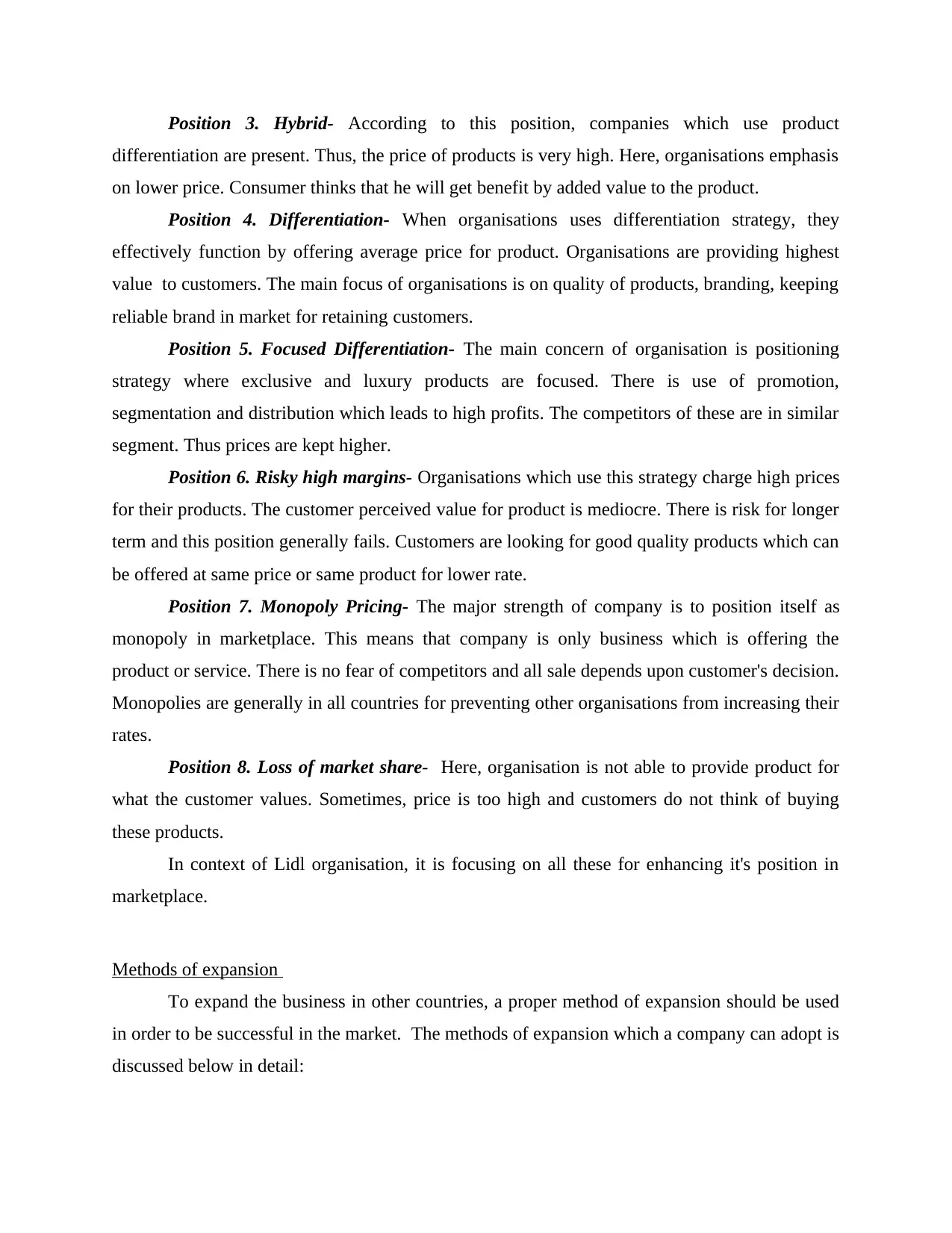
Position 3. Hybrid- According to this position, companies which use product
differentiation are present. Thus, the price of products is very high. Here, organisations emphasis
on lower price. Consumer thinks that he will get benefit by added value to the product.
Position 4. Differentiation- When organisations uses differentiation strategy, they
effectively function by offering average price for product. Organisations are providing highest
value to customers. The main focus of organisations is on quality of products, branding, keeping
reliable brand in market for retaining customers.
Position 5. Focused Differentiation- The main concern of organisation is positioning
strategy where exclusive and luxury products are focused. There is use of promotion,
segmentation and distribution which leads to high profits. The competitors of these are in similar
segment. Thus prices are kept higher.
Position 6. Risky high margins- Organisations which use this strategy charge high prices
for their products. The customer perceived value for product is mediocre. There is risk for longer
term and this position generally fails. Customers are looking for good quality products which can
be offered at same price or same product for lower rate.
Position 7. Monopoly Pricing- The major strength of company is to position itself as
monopoly in marketplace. This means that company is only business which is offering the
product or service. There is no fear of competitors and all sale depends upon customer's decision.
Monopolies are generally in all countries for preventing other organisations from increasing their
rates.
Position 8. Loss of market share- Here, organisation is not able to provide product for
what the customer values. Sometimes, price is too high and customers do not think of buying
these products.
In context of Lidl organisation, it is focusing on all these for enhancing it's position in
marketplace.
Methods of expansion
To expand the business in other countries, a proper method of expansion should be used
in order to be successful in the market. The methods of expansion which a company can adopt is
discussed below in detail:
differentiation are present. Thus, the price of products is very high. Here, organisations emphasis
on lower price. Consumer thinks that he will get benefit by added value to the product.
Position 4. Differentiation- When organisations uses differentiation strategy, they
effectively function by offering average price for product. Organisations are providing highest
value to customers. The main focus of organisations is on quality of products, branding, keeping
reliable brand in market for retaining customers.
Position 5. Focused Differentiation- The main concern of organisation is positioning
strategy where exclusive and luxury products are focused. There is use of promotion,
segmentation and distribution which leads to high profits. The competitors of these are in similar
segment. Thus prices are kept higher.
Position 6. Risky high margins- Organisations which use this strategy charge high prices
for their products. The customer perceived value for product is mediocre. There is risk for longer
term and this position generally fails. Customers are looking for good quality products which can
be offered at same price or same product for lower rate.
Position 7. Monopoly Pricing- The major strength of company is to position itself as
monopoly in marketplace. This means that company is only business which is offering the
product or service. There is no fear of competitors and all sale depends upon customer's decision.
Monopolies are generally in all countries for preventing other organisations from increasing their
rates.
Position 8. Loss of market share- Here, organisation is not able to provide product for
what the customer values. Sometimes, price is too high and customers do not think of buying
these products.
In context of Lidl organisation, it is focusing on all these for enhancing it's position in
marketplace.
Methods of expansion
To expand the business in other countries, a proper method of expansion should be used
in order to be successful in the market. The methods of expansion which a company can adopt is
discussed below in detail:
Paraphrase This Document
Need a fresh take? Get an instant paraphrase of this document with our AI Paraphraser
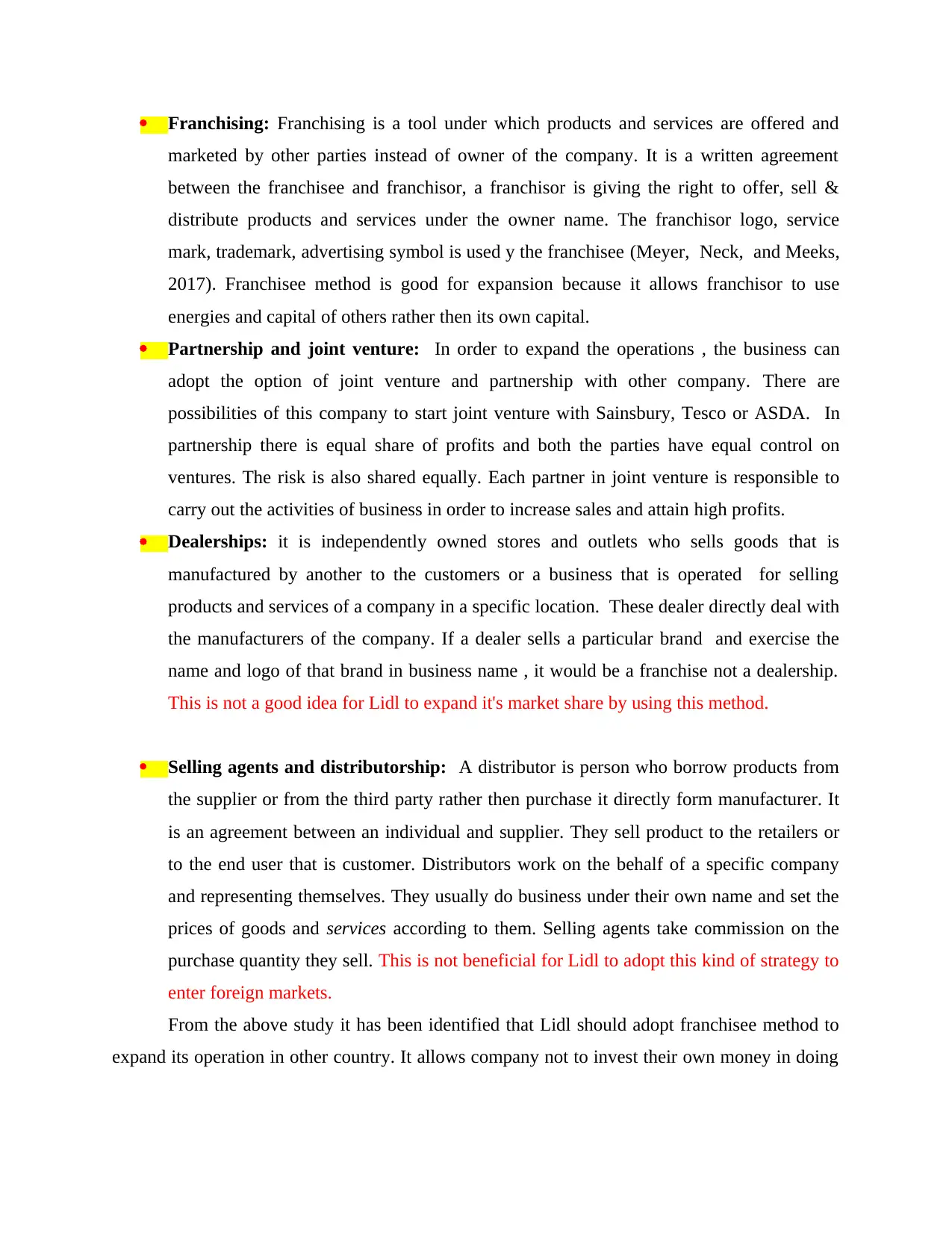
Franchising: Franchising is a tool under which products and services are offered and
marketed by other parties instead of owner of the company. It is a written agreement
between the franchisee and franchisor, a franchisor is giving the right to offer, sell &
distribute products and services under the owner name. The franchisor logo, service
mark, trademark, advertising symbol is used y the franchisee (Meyer, Neck, and Meeks,
2017). Franchisee method is good for expansion because it allows franchisor to use
energies and capital of others rather then its own capital.
Partnership and joint venture: In order to expand the operations , the business can
adopt the option of joint venture and partnership with other company. There are
possibilities of this company to start joint venture with Sainsbury, Tesco or ASDA. In
partnership there is equal share of profits and both the parties have equal control on
ventures. The risk is also shared equally. Each partner in joint venture is responsible to
carry out the activities of business in order to increase sales and attain high profits.
Dealerships: it is independently owned stores and outlets who sells goods that is
manufactured by another to the customers or a business that is operated for selling
products and services of a company in a specific location. These dealer directly deal with
the manufacturers of the company. If a dealer sells a particular brand and exercise the
name and logo of that brand in business name , it would be a franchise not a dealership.
This is not a good idea for Lidl to expand it's market share by using this method.
Selling agents and distributorship: A distributor is person who borrow products from
the supplier or from the third party rather then purchase it directly form manufacturer. It
is an agreement between an individual and supplier. They sell product to the retailers or
to the end user that is customer. Distributors work on the behalf of a specific company
and representing themselves. They usually do business under their own name and set the
prices of goods and services according to them. Selling agents take commission on the
purchase quantity they sell. This is not beneficial for Lidl to adopt this kind of strategy to
enter foreign markets.
From the above study it has been identified that Lidl should adopt franchisee method to
expand its operation in other country. It allows company not to invest their own money in doing
marketed by other parties instead of owner of the company. It is a written agreement
between the franchisee and franchisor, a franchisor is giving the right to offer, sell &
distribute products and services under the owner name. The franchisor logo, service
mark, trademark, advertising symbol is used y the franchisee (Meyer, Neck, and Meeks,
2017). Franchisee method is good for expansion because it allows franchisor to use
energies and capital of others rather then its own capital.
Partnership and joint venture: In order to expand the operations , the business can
adopt the option of joint venture and partnership with other company. There are
possibilities of this company to start joint venture with Sainsbury, Tesco or ASDA. In
partnership there is equal share of profits and both the parties have equal control on
ventures. The risk is also shared equally. Each partner in joint venture is responsible to
carry out the activities of business in order to increase sales and attain high profits.
Dealerships: it is independently owned stores and outlets who sells goods that is
manufactured by another to the customers or a business that is operated for selling
products and services of a company in a specific location. These dealer directly deal with
the manufacturers of the company. If a dealer sells a particular brand and exercise the
name and logo of that brand in business name , it would be a franchise not a dealership.
This is not a good idea for Lidl to expand it's market share by using this method.
Selling agents and distributorship: A distributor is person who borrow products from
the supplier or from the third party rather then purchase it directly form manufacturer. It
is an agreement between an individual and supplier. They sell product to the retailers or
to the end user that is customer. Distributors work on the behalf of a specific company
and representing themselves. They usually do business under their own name and set the
prices of goods and services according to them. Selling agents take commission on the
purchase quantity they sell. This is not beneficial for Lidl to adopt this kind of strategy to
enter foreign markets.
From the above study it has been identified that Lidl should adopt franchisee method to
expand its operation in other country. It allows company not to invest their own money in doing
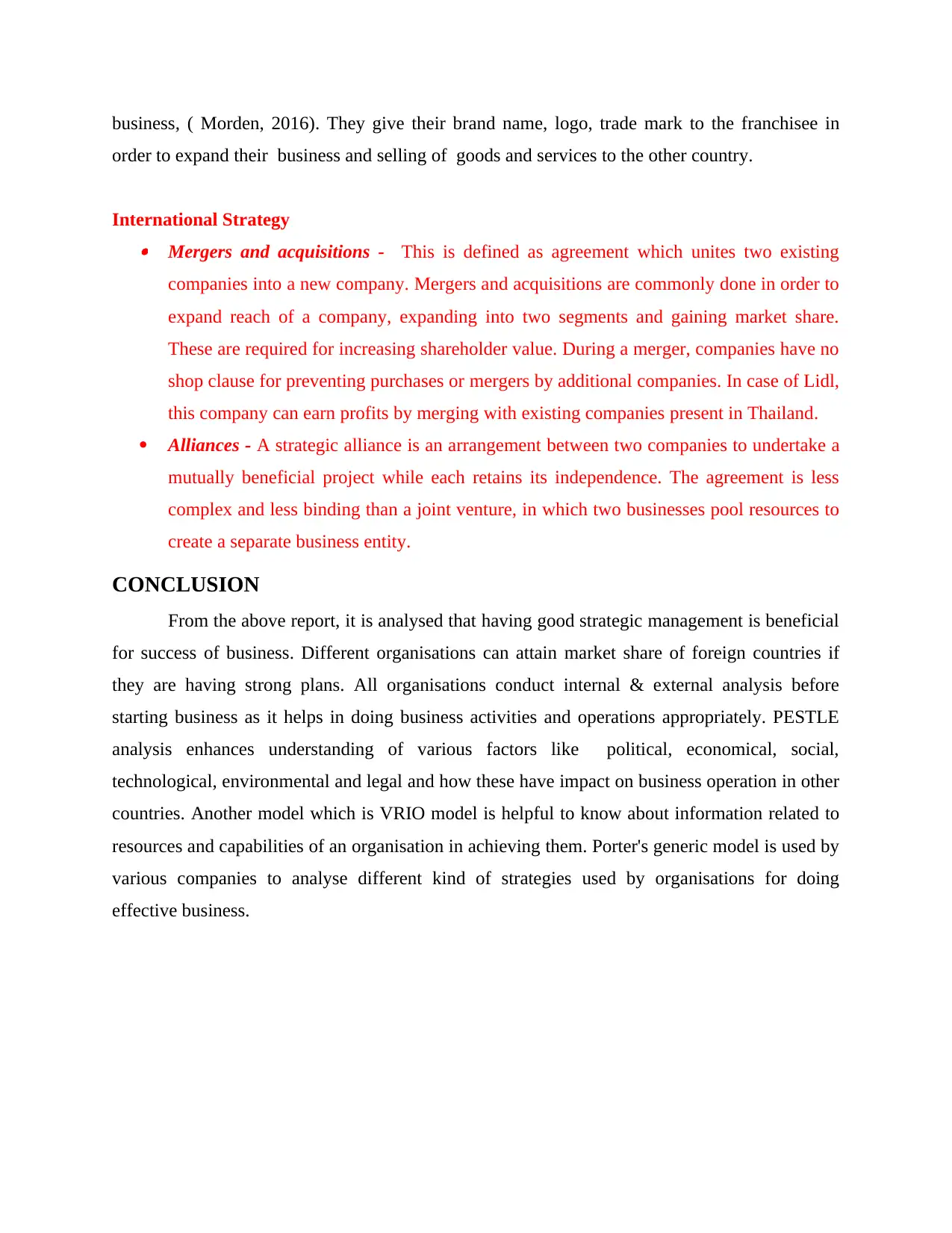
business, ( Morden, 2016). They give their brand name, logo, trade mark to the franchisee in
order to expand their business and selling of goods and services to the other country.
International Strategy Mergers and acquisitions - This is defined as agreement which unites two existing
companies into a new company. Mergers and acquisitions are commonly done in order to
expand reach of a company, expanding into two segments and gaining market share.
These are required for increasing shareholder value. During a merger, companies have no
shop clause for preventing purchases or mergers by additional companies. In case of Lidl,
this company can earn profits by merging with existing companies present in Thailand.
Alliances - A strategic alliance is an arrangement between two companies to undertake a
mutually beneficial project while each retains its independence. The agreement is less
complex and less binding than a joint venture, in which two businesses pool resources to
create a separate business entity.
CONCLUSION
From the above report, it is analysed that having good strategic management is beneficial
for success of business. Different organisations can attain market share of foreign countries if
they are having strong plans. All organisations conduct internal & external analysis before
starting business as it helps in doing business activities and operations appropriately. PESTLE
analysis enhances understanding of various factors like political, economical, social,
technological, environmental and legal and how these have impact on business operation in other
countries. Another model which is VRIO model is helpful to know about information related to
resources and capabilities of an organisation in achieving them. Porter's generic model is used by
various companies to analyse different kind of strategies used by organisations for doing
effective business.
order to expand their business and selling of goods and services to the other country.
International Strategy Mergers and acquisitions - This is defined as agreement which unites two existing
companies into a new company. Mergers and acquisitions are commonly done in order to
expand reach of a company, expanding into two segments and gaining market share.
These are required for increasing shareholder value. During a merger, companies have no
shop clause for preventing purchases or mergers by additional companies. In case of Lidl,
this company can earn profits by merging with existing companies present in Thailand.
Alliances - A strategic alliance is an arrangement between two companies to undertake a
mutually beneficial project while each retains its independence. The agreement is less
complex and less binding than a joint venture, in which two businesses pool resources to
create a separate business entity.
CONCLUSION
From the above report, it is analysed that having good strategic management is beneficial
for success of business. Different organisations can attain market share of foreign countries if
they are having strong plans. All organisations conduct internal & external analysis before
starting business as it helps in doing business activities and operations appropriately. PESTLE
analysis enhances understanding of various factors like political, economical, social,
technological, environmental and legal and how these have impact on business operation in other
countries. Another model which is VRIO model is helpful to know about information related to
resources and capabilities of an organisation in achieving them. Porter's generic model is used by
various companies to analyse different kind of strategies used by organisations for doing
effective business.
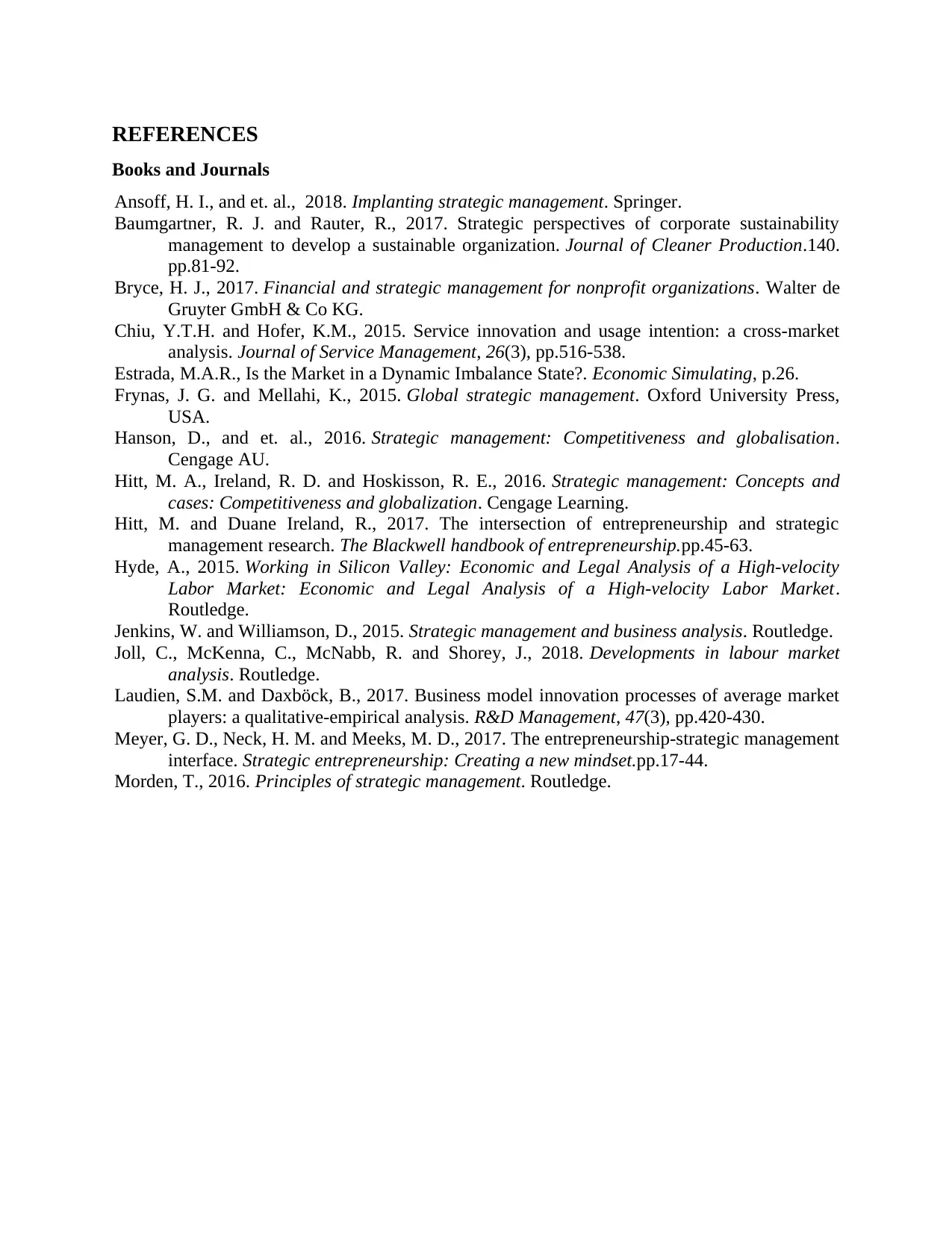
REFERENCES
Books and Journals
Ansoff, H. I., and et. al., 2018. Implanting strategic management. Springer.
Baumgartner, R. J. and Rauter, R., 2017. Strategic perspectives of corporate sustainability
management to develop a sustainable organization. Journal of Cleaner Production.140.
pp.81-92.
Bryce, H. J., 2017. Financial and strategic management for nonprofit organizations. Walter de
Gruyter GmbH & Co KG.
Chiu, Y.T.H. and Hofer, K.M., 2015. Service innovation and usage intention: a cross-market
analysis. Journal of Service Management, 26(3), pp.516-538.
Estrada, M.A.R., Is the Market in a Dynamic Imbalance State?. Economic Simulating, p.26.
Frynas, J. G. and Mellahi, K., 2015. Global strategic management. Oxford University Press,
USA.
Hanson, D., and et. al., 2016. Strategic management: Competitiveness and globalisation.
Cengage AU.
Hitt, M. A., Ireland, R. D. and Hoskisson, R. E., 2016. Strategic management: Concepts and
cases: Competitiveness and globalization. Cengage Learning.
Hitt, M. and Duane Ireland, R., 2017. The intersection of entrepreneurship and strategic
management research. The Blackwell handbook of entrepreneurship.pp.45-63.
Hyde, A., 2015. Working in Silicon Valley: Economic and Legal Analysis of a High-velocity
Labor Market: Economic and Legal Analysis of a High-velocity Labor Market.
Routledge.
Jenkins, W. and Williamson, D., 2015. Strategic management and business analysis. Routledge.
Joll, C., McKenna, C., McNabb, R. and Shorey, J., 2018. Developments in labour market
analysis. Routledge.
Laudien, S.M. and Daxböck, B., 2017. Business model innovation processes of average market
players: a qualitative‐empirical analysis. R&D Management, 47(3), pp.420-430.
Meyer, G. D., Neck, H. M. and Meeks, M. D., 2017. The entrepreneurship‐strategic management
interface. Strategic entrepreneurship: Creating a new mindset.pp.17-44.
Morden, T., 2016. Principles of strategic management. Routledge.
Books and Journals
Ansoff, H. I., and et. al., 2018. Implanting strategic management. Springer.
Baumgartner, R. J. and Rauter, R., 2017. Strategic perspectives of corporate sustainability
management to develop a sustainable organization. Journal of Cleaner Production.140.
pp.81-92.
Bryce, H. J., 2017. Financial and strategic management for nonprofit organizations. Walter de
Gruyter GmbH & Co KG.
Chiu, Y.T.H. and Hofer, K.M., 2015. Service innovation and usage intention: a cross-market
analysis. Journal of Service Management, 26(3), pp.516-538.
Estrada, M.A.R., Is the Market in a Dynamic Imbalance State?. Economic Simulating, p.26.
Frynas, J. G. and Mellahi, K., 2015. Global strategic management. Oxford University Press,
USA.
Hanson, D., and et. al., 2016. Strategic management: Competitiveness and globalisation.
Cengage AU.
Hitt, M. A., Ireland, R. D. and Hoskisson, R. E., 2016. Strategic management: Concepts and
cases: Competitiveness and globalization. Cengage Learning.
Hitt, M. and Duane Ireland, R., 2017. The intersection of entrepreneurship and strategic
management research. The Blackwell handbook of entrepreneurship.pp.45-63.
Hyde, A., 2015. Working in Silicon Valley: Economic and Legal Analysis of a High-velocity
Labor Market: Economic and Legal Analysis of a High-velocity Labor Market.
Routledge.
Jenkins, W. and Williamson, D., 2015. Strategic management and business analysis. Routledge.
Joll, C., McKenna, C., McNabb, R. and Shorey, J., 2018. Developments in labour market
analysis. Routledge.
Laudien, S.M. and Daxböck, B., 2017. Business model innovation processes of average market
players: a qualitative‐empirical analysis. R&D Management, 47(3), pp.420-430.
Meyer, G. D., Neck, H. M. and Meeks, M. D., 2017. The entrepreneurship‐strategic management
interface. Strategic entrepreneurship: Creating a new mindset.pp.17-44.
Morden, T., 2016. Principles of strategic management. Routledge.
1 out of 16
Related Documents
Your All-in-One AI-Powered Toolkit for Academic Success.
+13062052269
info@desklib.com
Available 24*7 on WhatsApp / Email
![[object Object]](/_next/static/media/star-bottom.7253800d.svg)
Unlock your academic potential
© 2024 | Zucol Services PVT LTD | All rights reserved.





